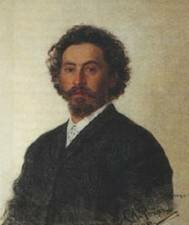 Ilja Efimovich Repin05.08.1844 Chuguev, Kharkov region, Ukraine - 29.09.1930 Kuokkala, now Repino in Leningrad region Art history: PeredvizhnikiCanvases of Ilja Efimovich Repin [33 canvases]
Biography of Ilja Efimovich RepinIlya Efimovich Repin was born in 1844 in a small Ukrainian town of Tchuguev in the family of a military settler. As a boy he was trained as an icon painter. At the age of 19 he entered the St. Petersburg Academy of Arts. His arrival to the capital coincided with an important event in artistic life of the 60s, the so-called ‘Riot of the Fourteen’, when 14 young artists left the Academy having refused to use mythological subjects for their diploma works. They stood on the point that art should be close to real life. Later Repin would be closely connected with some of them, the members of the Society of Peredvizhniky. For his diploma work Raising of Jairus' Daughter (1871) Repin was awarded The Major Gold Medal and received a scholarship for studies abroad. Barge Haulers on the Volga (1870-1873) was the first considerable work painted by Repin after graduation. It immediately won recognition. In 1873, Repin went abroad. For some months he had been traveling in Italy and then settled and worked in Paris up to 1876. It was in Paris that he witnessed the first exhibition of the Impressionists, but, judging by the works created then and by his letters home, he didn't become the ardent follower of this new Paris school of painting, though he didn't share the opinion of some of his country-men who saw a dangerous departure from “the truth of life” in Impressionism. After returning to Russia Repin settled in Moscow. He was a frequent visitor in Abramtsevo – the country estate of Savva Mamontov, one of the most famous Russian patrons of art. It was a very fruitful period in his creative activity. During 10-12 years Repin created the majority of his famous paintings. In 1877, he started to paint religious processions (krestny khod): Krestny Khod (Religious Procession) in Kursk Gubernia (1880-1883). The composition was based on the dramatic effect of different attitude of the participants of the procession to the wonder-working icon carried at the head of the procession. There were two different versions of the picture. The second one, completed in 1883, became the most popular. At first glance, the spectator discovers an abundance of social types and human characters in the crowd . A series of paintings devoted to the revolution theme deserves special attention. The artist was no doubt interested in creating the character of a fighter for social justice. The range of social, spiritual and psychological problems, which attracted Repin, is revealed in his works: Unexpected Return (1884) and Refusal from the Confession (1879-1885). Repin is the author of many portraits, which are an essential part of his artistic heritage. Repin never painted faces, he painted real people, managing to show his models in their natural state, to reveal their way of communicating with the world: Portrait of the Composer Modest Musorgsky (1881), Portrait of the Surgeon Nikolay Pirogov (1881), Portrait of the Author Alexey Pisemsky (1880), Portrait of the Poet Afanasy Fet (1882), Portrait of the Art Critic Vladimir Stasov (1883), and Portrait of Leo Tolstoy (1887) and many others are distinguished by the power of the visual characteristic and the economy and sharpness of execution. Repin rarely painted historical paintings. The most popular in this genre is Ivan the Terrible and his son Ivan (1895). The expressive, intense composition and psychological insight in rendering the characters produced an unforgettable impression on the spectators. Another popular work of the genre is The Reply of the Zaporozhian Cossacks to Sultan Mahmoud IV (1880-1891). The faithfully rendered spirit of the Zaporoguus freemen, who, according to the artist, had a particularly strong sense of “liberty, equality and fraternity” undoubtedly gives the picture its significance. The contemporaries saw it as a symbol of the Russian people throwing off their chains. The last quarter of the 19th century is the best period in Repin’s work, though his creative activity continued in the 20th century (the artist died in 1930), he did not paint any masterpieces then. After the bolsheviks’ revolution in 1917 he lived and worked in his estate Penates in Finland. There is a Repin museum. The museum visitors have the opportunity of gaining a detailed knowledge of the artist's life and work.
You can find canvases of this artist in these museums:
|
Для красивого отображения Облака Quick Search artists |
|||||||||||||||